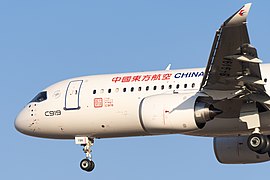CFM International LEAP
Last updated| LEAP | |
|---|---|
 | |
| Mockup of a LEAP-X, the early code name of the engine | |
| Type | Turbofan |
| National origin | France/United States |
| Manufacturer | CFM International |
| First run | 4 September 2013 [1] |
| Major applications | Airbus A320neo family Boeing 737 MAX Comac C919 |
| Number built | 2,516 (June 2019) [lower-alpha 1] |
| Developed from | CFM International CFM56 General Electric GEnx |
| Developed into | General Electric Passport |
The CFM International LEAP ("Leading Edge Aviation Propulsion" [6] ) is a high-bypass turbofan engine produced by CFM International, a 50–50 joint venture between American GE Aerospace (formerly GE Aviation) and French Safran Aircraft Engines (formerly Snecma). It is the successor of the CFM56 and competes with the Pratt & Whitney PW1000G to power narrow-body aircraft.
Contents
Design
The LEAP's basic architecture includes a scaled-down version of Safran's low pressure turbine used on the GEnx engine. The fan has flexible blades manufactured by a resin transfer molding process, which are designed to untwist as the fan's rotational speed increases. While the LEAP is designed to operate at a higher pressure than the CFM56 (which is partly why it is more efficient), CFM plans to set the operating pressure lower than the maximum to maximize the engine's service life and reliability. [7] Currently proposed for the LEAP is a greater use of composite materials, a blisk fan in the compressor, a second-generation Twin Annular Pre-mixing Swirler (TAPS II) combustor, and a bypass ratio around 10–11:1.
The high-pressure (HP) compressor operates at up to a 22:1 compression ratio, which is roughly double the corresponding value for the CFM56's HP compressor. [8]
CFM uses ceramic matrix composites (CMC) to build the turbine shrouds. [9] These technological advances are projected to produce 16% lower fuel consumption. [10] [11] Reliability is also supported by use of an eductor-based oil cooling system similar to that of the GEnx, featuring coolers mounted on the inner lining of the fan duct. According to Aviation Week's article, "The eductor device produces a venturi effect, which ensures a positive pressure to keep oil in the lower internal sump." [7] The engine has some of the first FAA-approved 3D-printed components. [12]
Development
The LEAP ("Leading Edge Aviation Propulsion") [14] incorporates technologies that CFM developed as part of the LEAP56 technology acquisition program, which CFM launched in 2005. [15] The engine was officially launched as LEAP-X on 13 July 2008. [10] It is intended to be a successor to the CFM56-5B and CFM56-7B.
In 2009, COMAC selected the LEAP engine for the C919. [16] The aircraft was due to begin testing in 2016. [17] In total, 28 test engines will be used by CFM to achieve engine certification, and 32 others will be used by Airbus, Boeing and COMAC for aircraft certification and test programs. [1] [18] The first engine entering the test program reached and sustained 33,000 lbf (150 kN) of thrust, required to satisfy the highest rating for the Airbus A321neo. The same engine ultimately reached 35,000 lbf (160 kN) of thrust in test runs. [7]
CFM carried out the first test flight, of a LEAP-1C, in Victorville, California, with the engine mounted on the company's Boeing 747 flying testbed aircraft, on 6 October 2014. The -1C version features a thrust reverser equipped with a one piece O-ring replacing a 2 piece door. The thrust reverser is deployed by the O-ring sliding aft, reducing the drag that was induced by the older design and improving efficiency. [19] In April 2015, it was reported that the LEAP-1B was suffering up to a 5% shortfall on its promised reduction in fuel consumption. [20] It obtained its 180-minute ETOPS approval from the U.S. Federal Aviation Administration and the European Aviation Safety Agency on 19 June 2017. [21]
Orders
On 20 July 2011, American Airlines announced that it planned to purchase 100 Boeing 737 aircraft featuring the LEAP-1B engine. [22] The project was approved by Boeing on 30 August 2011, as the Boeing 737 MAX. [23] [24] Southwest Airlines is the launch customer of the 737 MAX with a firm order of 150 aircraft. [25]
The list price of a LEAP-1A is USD14.5 million, [26] and USD14.5 million for a LEAP-1B. [27]
CFM International offers its support for the engine, and signed a 15-year Rate per Flight Hour agreement with Loong Air for 20 LEAP-1A at U.S $333 million, or $3039 per engine per day, in contrast with U.S. $138 million for 17 CFM International CFM56 over 12 years or $1852 per engine per day. [28] As a number of A320neo engine for ANA group of Japan was also ordered in 2014, there is a possibility to select the LEAP engine. [29]
In 2016 CFM booked 1,801 orders, LEAP backlog is at more than 12,200 for more than $170 billion U.S. at list price. [2] In early 2018, the backlog was at 14,500, with a 59% share of the A320neo market for decided customers as it has an 18 percentage point advantage in utilization rate over the Pratt & Whitney PW1000G. [30]
By July 2018, the LEAP had an eight-year backlog with 16,300 sales. More LEAPs were produced in the five years to 2018 than CFM56s in 25 years. [3] It is the second-most ordered jet engine behind the 44-year-old CFM56, [31] which achieved 35,500 orders. [3] In July 2018 its A320neo selected-engine market share was 58.6%, with one-third yet to select, the CFM56 have a 60% share of the A320ceo market. [31]
In 2020, GE Aviation lost 1,900 orders worth $13.9 billion ($7.3M each), reducing the backlog value to $259 billion, while more than 1,000 Boeing 737 Max orders were cancelled among the Boeing 737 MAX groundings and the impact of the COVID-19 pandemic on aviation. [32]
Production

In 2016, the engine was introduced in August on the Airbus A320neo with Pegasus Airlines and CFM delivered 77 LEAP. [2] With the 737 MAX introduction, CFM delivered 257 LEAPs in the first three quarters of 2017, including 110 in the third: 49 to Airbus and 61 to Boeing, and targets 450 in the year. [33] CFM was to produce 1,200 engines in 2018, 1,900 in 2019, and 2,100 in 2020. [34] This is compared to the 1,700 CFM56 produced in 2016. [35]
To cope with the demand, CFM is duplicating supply sources on 80% of parts and even subdivide assembly sites, already shared between GE and Safran. [36] GE assembles its production in Lafayette, Indiana, US in addition to its previous Durham, North Carolina, US facility. [36] As more than 75% of the engine comes from suppliers, critical parts suppliers pass “run-rate stress tests” lasting two to 12 weeks. [36] Pratt & Whitney acknowledges a production ramp-up bottleneck on its rival PW1100G geared turbofan including a critical shortage of the unique aluminium-titanium fan blade, hitting the Airbus A320neo and the Bombardier CSeries deliveries. [36] Safran assembles its production in Villaroche, France, Safran and GE each assemble half of the annual volume. [37] Mecachrome plan to produce 120,000–130,000 LEAP turbine blades in 2018 up from 50,000 in 2017. [38]
In mid-June 2018, deliveries remained four to five weeks behind schedule down from six, and should catch up in the fourth quarter as the quality variation of castings and forgings improves. [3] The production has no single manufacturing choke point by selecting multiple suppliers for every critical part. [3] From 460 in 2017, 1,100 LEAPs should be built in 2018, along 1,050 CFM56s as it encounter unexpected sales, to pass the record production of 1,900 engines in 2017. [3] It will stay over 2,000 engines per year as 1,800 LEAPs should be produced in 2019 while CFM56 production will drop, then 2,000 in 2020. [3] In 2018, 1,118 engines were delivered. [4]
Over the first half of 2019, CFM revenues were up by 23% to €5.9 billion with 1,119 engine deliveries; declining sales of CFM56 (258 sold), more than offset by LEAP (861 sold). [5] Recurring operating income rose by 34% to €1.2 billion, but was reduced by €107 million ($118 million) due to the negative margins and initial costs of LEAP production, before a positive contribution expected in the second half. [5] Revenues should grow by 15% in 2019 but free cash flow depends on the return to service of the grounded 737 MAX. [5]
In 2019, LEAP production rose to 1,736 engines, orders and commitments reached 1,968 amid the 737 MAX groundings, compared with 3,211 for 2018, for a stable backlog of 15,614 (compared to 15,620). [39] CFM expects to produce 1,400 LEAP engines in 2020, including an average of 10 weekly LEAP-1Bs for the Boeing 737 Max. [39] By March 2022, CFM intended to output 2,000 engines in 2023, up from 845 deliveries in 2021. [40]
Operations
The troubled introduction of the PW1100G on the A320neo has motivated customers to choose LEAP engines. LEAP market share rose from 55% to 60% in 2016, but orders for 1,523 aircraft (29%) had not specified which engine would be chosen. [41] From January through early August 2017, 39 PW1100G engines versus 396 CFM LEAP engines were chosen. [41] As an example of PW1100G reliability issues, 9% of LEAP-powered A320neos were out of service for at least one week in July 2017, compared with 46% of those using the PW1100G. [41]
The Boeing 737 MAX LEAP-1B started revenue service in May 2017 with Malindo Air with 8 hours of daily operation, while the A320neo LEAP-1A surpassed 10 hours per day by July. Safran discovered a production quality defect on LEAP-1B low-pressure turbine disks during assembly for possibly 30 engines and CFM is working to minimize flight-test and customer-delivery disruptions. [42]
In early October 2017, an exhaust gas temperature shift was noticed during a flight and a CMC shroud coating in the HP turbine was seen flaking off in a borescope inspection, creating a leaking gap: eight in-service engines are seeing their coating replaced. [43] Safran provisioned €50 million ($58 million) to trouble-shoot in-service engines, including potentially LEAP-1Bs. [33] Forty LEAP-1A were replaced and the part should be replaced in over 500 in-service engines, while shipments are four weeks behind schedule. [44] Deliveries with the permanent CMC environmental-barrier coating fix began in June. [45]
On 26 March 2019, due to the Boeing 737 MAX groundings, Southwest Airlines flight 8701 (737 MAX 8) took off from Orlando International Airport for a ferry flight to storage without passengers, but soon after problems with one of the engines caused an emergency landing at the same airport. Southwest then inspected 12 LEAP engines and two other airlines also inspected their engines. [46] CFM recommended replacing the fuel nozzles more often due to coking, a carbon buildup. [47]
By December 2021, CFM claimed a 72% share of the narrowbody market. [48]
Applications
| Model | Application | Thrust range | Introduction |
|---|---|---|---|
| -1A | Airbus A320neo family | 24,500–35,000 lbf (109–156 kN) | 2 August 2016 [50] |
| -1B | Boeing 737 MAX | 23,000–28,000 lbf (100–120 kN) | 22 May 2017 [51] |
| -1C | Comac C919 | 27,980–30,000 lbf (124.5–133.4 kN) | 28 May 2023 [52] |
- The LEAP-1A installed on the Airbus A320neo family.
- The LEAP-1B installed on the Boeing 737 MAX.
- The LEAP-1C is the exclusive engine option for the Chinese Comac C919.
Specifications

| Model | LEAP-1A [53] | LEAP-1B [54] | LEAP-1C [53] |
|---|---|---|---|
| Configuration | Twin-spool, high bypass turbofan | ||
| Compressor | 1 fan, 3-stage LP, 10-stage HP [55] | ||
| Combustor | Second generation Twin-Annular, Pre-Mixing Swirler Combustor (TAPS II) [49] | ||
| Turbine | 2-stage HP, 7-stage (-1B: 5-stage) LP [56] | ||
| OPR | 40:1 [55] (50:1, Top-of-Climb) | ||
| Cruise TSFC | 0.51 lb/lbf/h (14.4 g/kN/s) [57] | 0.53 lb/lbf/h (15.0 g/kN/s) [57] | 0.51 lb/lbf/h (14.4 g/kN/s) [58] |
| Fan diameter [55] | 78 in (198 cm) | 69.4 in (176 cm) | 77 in (196 cm) [59] |
| Bypass ratio [55] | 11:1 | 9:1 | 11:1 |
| Length | 3.328 m (131.0 in) [lower-alpha 2] | 3.147 m (123.9 in) | 4.505 m (177.4 in) [lower-alpha 3] |
| Max. Width | 2.533–2.543 m (99.7–100.1 in) | 2.421 m (95.3 in) | 2.659 m (104.7 in) |
| Max. Height | 2.368–2.362 m (93.2–93.0 in) | 2.256 m (88.8 in) | 2.714 m (106.9 in) |
| Weight | 2,990–3,153 kg (6,592–6,951 lb) (Wet) | 2,780 kg (6,130 lb) (Dry) | 3,929–3,935 kg (8,662–8,675 lb) (Wet) |
| Max. Take-Off thrust | 143.05 kN (32,160 lbf) | 130.41 kN (29,320 lbf) | 137.14 kN (30,830 lbf) |
| Max. Continuous | 140.96 kN (31,690 lbf) | 127.62 kN (28,690 lbf) | 133.22 kN (29,950 lbf) |
| Max. rpm | LP : 3894, HP : 19391 | LP : 4586, HP : 20171 | LP : 3894, HP : 19391 |
| Variant | Take-Off Thrust | Max. Continuous |
|---|---|---|
| -1A23 | 106.80 kN (24,010 lbf) | 104.58 kN (23,510 lbf) |
| -1A24 | 106.80 kN (24,010 lbf) | 106.76 kN (24,000 lbf) |
| -1B25 | 119.15 kN (26,790 lbf) | 115.47 kN (25,960 lbf) |
| -1A26 | 120.64 kN (27,120 lbf) | 118.68 kN (26,680 lbf) |
| -1B27 | 124.71 kN (28,040 lbf) | 121.31 kN (27,270 lbf) |
| -1B28 | 130.41 kN (29,320 lbf) | 127.62 kN (28,690 lbf) |
| -1C28 | 129.98 kN (29,220 lbf) | 127.93 kN (28,760 lbf) |
| -1C30 | 137.14 kN (30,830 lbf) | 133.22 kN (29,950 lbf) |
| -1A30, 32, 33, 35A | 143.05 kN (32,160 lbf) | 140.96 kN (31,690 lbf) |
See also
Related development
Comparable engines
Related lists
Related Research Articles

The Boeing 737 is a narrow-body aircraft produced by Boeing at its Everett and Renton factories in Washington. Developed to supplement the Boeing 727 on short and thin routes, the twinjet retains the 707 fuselage width and six abreast seating but with two underwing turbofans instead of four. Envisioned in 1964, the initial 737-100 made its first flight in April 1967 and entered service in February 1968 with Lufthansa. The lengthened 737-200 entered service in April 1968, and evolved through four generations, offering several variants for 85 to 215 passengers.
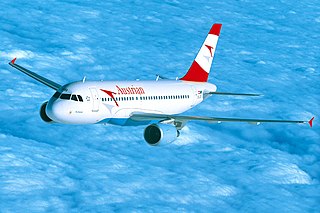
The Airbus A319 is a member of the Airbus A320 family of short- to medium-range, narrow-body, commercial passenger twin-engine jet airliners manufactured by Airbus. The A319 carries 124 to 156 passengers and has a maximum range of 3,700 nmi. Final assembly of the aircraft takes place in Hamburg, Germany and Tianjin, China.

The Airbus A320 family is a series of narrow-body airliners developed and produced by Airbus. The A320 was launched in March 1984, first flew on 22 February 1987, and was introduced in April 1988 by Air France. The first member of the family was followed by the longer A321, the shorter A319, and the even shorter A318 . Final assembly takes place in Toulouse in France; Hamburg in Germany; Tianjin in China since 2009; and Mobile, Alabama in the United States since April 2016.

The Airbus A321 is a member of the Airbus A320 family of short to medium range, narrow-body, commercial passenger twin engine jet airliners; it carries 185 to 236 passengers. It has a stretched fuselage which was the first derivative of the baseline A320 and entered service in 1994, about six years after the original A320. The aircraft shares a common type rating with all other Airbus A320-family variants, allowing previous A320-family pilots to fly the aircraft without the need for further training.

The Airbus A318 is the smallest and least numerous variant airliner of the Airbus A320 family. The A318 carries 107 to 132 passengers and has a maximum range of 5,750 kilometres. Final assembly of the aircraft took place in Hamburg, Germany. It is intended primarily for short-range service.

The CFM International CFM56 series is a Franco-American family of high-bypass turbofan aircraft engines made by CFM International (CFMI), with a thrust range of 18,500 to 34,000 lbf. CFMI is a 50–50 joint-owned company of Safran Aircraft Engines of France, and GE Aerospace (GE) of the United States. Both companies are responsible for producing components and each has its own final assembly line. GE produces the high-pressure compressor, combustor, and high-pressure turbine, Safran manufactures the fan, gearbox, exhaust and the low-pressure turbine, and some components are made by Avio of Italy and Honeywell from the US. The engines are assembled by GE in Evendale, Ohio, and by Safran in Villaroche, France. The completed engines are marketed by CFMI. Despite initial export restrictions, it is the most used turbofan aircraft engine in the world, in four major variants.

CFM International is a aircraft engine manufacturer based in Cincinnati, U.S. The company is a joint venture between GE Aerospace and Safran Aircraft Engines. It was originally formed to build and support the CFM56 series of turbofan engines. The company is a large supplier of commercial aircraft engines, delivering to date more than 37,500 of its engines to more than 570 operators. As of 2019, it holds 39% of the world's commercial aircraft engine market share.

Safran Aircraft Engines, previously Snecma or Snecma Moteurs, is a French aerospace engine manufacturer headquartered in Courcouronnes and a subsidiary of Safran. It designs, manufactures and maintains engines for commercial and military aircraft as well as rocket engines for launch vehicles and satellites.

A narrow-body aircraft or single-aisle aircraft is an airliner arranged along a single aisle, permitting up to 6-abreast seating in a cabin less than 4 metres (13 ft) in width. In contrast, a wide-body aircraft is a larger airliner usually configured with multiple aisles and a fuselage diameter of more than 5 metres (16 ft), allowing at least seven-abreast seating and often more travel classes.

The Pratt & Whitney PW1000G, also called the GTF, is a high-bypass geared turbofan engine family produced by Pratt & Whitney. After many demonstrators, the program was launched with the PW1200G on the Mitsubishi SpaceJet in March 2008, first flight tested in July 2008. The first variant to be certified was the PW1500G for the Airbus A220 in February 2013. The program cost is estimated at $10 billion.
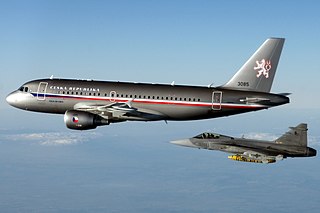
Airbus Corporate Jets, a business unit of Airbus SAS and part of Airbus, markets and completes corporate jet variants from the parent's airliner range. Types include the A318 Elite to the double/triple-decked Airbus A380 Prestige. Following the entry of the 737-based Boeing Business Jet, Airbus joined the business jet market with the A319 Corporate Jet in 1997. Although the term Airbus Corporate jet was initially used only for the A319CJ, it is now often used for all models, including the VIP widebodies. As of June 2019, 213 corporate and private jets are operating; 222 aircraft have been ordered, including 128 A320 family jets.

The Boeing 737 Next Generation, commonly abbreviated as 737NG, or 737 Next Gen, is a narrow-body aircraft powered by two jet engines and produced by Boeing Commercial Airplanes. Launched in 1993 as the third generation derivative of the Boeing 737, it has been produced since 1997 and is an upgrade of the 737 Classic (−300/-400/-500) series.

The Comac C919 is a narrow-body airliner developed by Chinese aircraft manufacturer Comac. The development program was launched in 2008. Production began in December 2011, with the first prototype rolled out on 2 November 2015 and having its maiden flight on 5 May 2017. On 29 September 2022, the C919 received its CAAC type certificate. The first production airframe was delivered to China Eastern Airlines on 9 December 2022 and was put into commercial passenger service on 28 May 2023.

The General Electric Passport is a turbofan developed by GE Aerospace for large business jets. It was selected in 2010 to power the Bombardier Global 7500 and 8000, first run on June 24, 2013, and first flown in 2015. It was certified in April 2016 and powered the Global 7500 first flight on November 4, 2016, before its 2018 introduction. It produces 14,000 to 20,000 lbf of thrust, a range previously covered by the General Electric CF34. A smaller scaled CFM LEAP, it is a twin-spool axial engine with a 5.6:1 bypass ratio and a 45:1 overall pressure ratio and is noted for its large one-piece 52 in (130 cm) fan 18-blade titanium blisk.
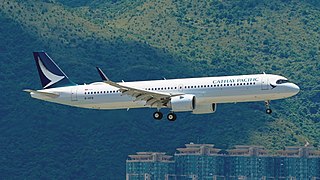
The Airbus A321neo is a single-aisle airliner created by Airbus. The A321neo is developed from the Airbus A321 and Airbus A320neo family. It is the longest stretched fuselage of Airbus's A320 series, and the newest version of the A321, with the original A321ceo entering service in 1994 with Lufthansa. It typically seats 180 to 220 passengers in a two-class configuration, with up to 244 passengers in a high-density arrangement.
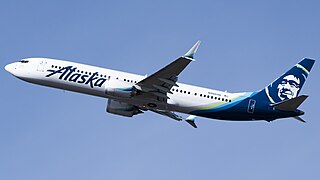
The Boeing 737 MAX is the fourth generation of the Boeing 737, a narrow-body airliner manufactured by Boeing Commercial Airplanes, a division of American company Boeing. It succeeds the Boeing 737 Next Generation (NG) and competes with the Airbus A320neo family. The new series was announced on August 30, 2011. It took its maiden flight on January 29, 2016 and was certified by the United States Federal Aviation Administration (FAA) in March 2017. The first delivery was a MAX 8 in May 2017 to Malindo Air, with which it commenced service on May 22, 2017.

The Airbus A320neo family is an incremental development of the A320 family of narrow-body airliners produced by Airbus. The A320neo family is based on the previous A319, A320, and A321, which was then renamed A320ceo, for "current engine option".
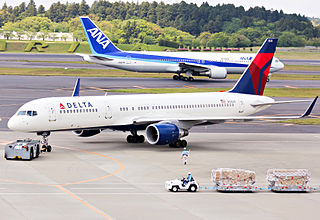
The New Midsize Airplane (NMA), or New Midsize Aircraft, is a concept airliner proposed by Boeing to fill the middle of the market segment.
The CFM International RISE is an open rotor engine currently under development by CFM International, a 50–50 joint venture between American GE Aerospace and French Safran Aircraft Engines. The engine is planned to support both hydrogen and sustainable aviation fuels, and it plans to achieve a 20% reduction in fuel burn and in carbon dioxide emissions compared to its predecessors.
References
- 1 2 "CFM launches a new era as first LEAP engine begins ground testing". CFM International. 6 September 2013. Archived from the original on 20 June 2015. Retrieved 7 September 2013.
- 1 2 3 "2016 CFM orders surpass 2,600 engines" (Press release). CFM International. 14 February 2017. Archived from the original on 10 December 2019. Retrieved 15 February 2017.
- 1 2 3 4 5 6 7 Chris Kjelgaard (4 July 2018). "CFM Confident Leap Production Can Catch Up Soon". AIN online. Archived from the original on 5 July 2018. Retrieved 5 July 2018.
- 1 2 Jon Hemmerdinger (1 February 2019). "MID SUPPLY CHAIN RECOVERY CFM's Leap deliveries doubled in 2018 amid supply chain recovery". Flightglobal. Archived from the original on 26 October 2019. Retrieved 26 October 2019.
- 1 2 3 4 David Kaminski-Morrow (5 September 2019). "Leap production edges towards positive contribution". Flightglobal. Archived from the original on 5 September 2019. Retrieved 5 September 2019.
- ↑ "Aircraft engines". Safran. Archived from the original on 6 August 2019. Retrieved 2 August 2019.
- 1 2 3 Guy Norris (28 October 2013). "Smooth Start To Fast-Paced Leap-1A Test Program". Archived from the original on 28 September 2018. Retrieved 5 July 2018. "Pressure testing" . Aviation Week & Space Technology. p. 43. Archived from the original on 5 July 2018. Retrieved 5 July 2018.
- ↑ Chandler, Jerome Greer (18 May 2017). "Taking the LEAP: CFM's successor to the fabulous 56". Aviation Pros. Retrieved 1 March 2022.
- ↑ Guy Norris (13 April 2015). "Pratt Targets Hot, Rotating Blade Use Of CMCs" . Archived from the original on 28 September 2018. Retrieved 5 July 2018. "Hot blades" (PDF). Aviation Week & Space Technology. 27 April 2015. p. 55. Archived (PDF) from the original on 5 July 2018. Retrieved 5 July 2018.
- 1 2 "CFM Unveils New LEAP-X Engine" (Press release). CFM International. 13 July 2008. Archived from the original on 5 July 2018. Retrieved 5 July 2018.
- ↑ "New engines: flurry of activity despite downturn". Flightglobal. 6 October 2009. Archived from the original on 9 May 2018. Retrieved 5 July 2018.
- ↑ Tomas Kellner (14 April 2015). "The FAA Cleared the First 3D Printed Part to Fly in a Commercial Jet Engine from GE". GE. Archived from the original on 29 June 2017. Retrieved 22 April 2015.
- ↑ Guy Norris (20 November 2015). "CFM Lifts Veil On Leap Engine Test Details". Aviation Week & Space Technology. Archived from the original on 11 February 2019. Retrieved 12 December 2018.
- ↑ "LEAP Turbofan Engine, History". Archived from the original on 3 September 2018. Retrieved 16 August 2012.
- ↑ "CFM Laying the Technology Foundation for the Future" (Press release). 13 June 2005. Archived from the original on 29 October 2009.. CFM International
- ↑ "CFM International to provide engines for COMAC's C919". flightglobal. 21 December 2009. Archived from the original on 15 November 2019. Retrieved 15 July 2018.
- ↑ "CFM to finish Leap core testing by mid-May". flightglobal. 28 April 2010. Archived from the original on 3 September 2014. Retrieved 15 July 2018.
- ↑ david kaminski morrow (22 April 2015). "First Leap-powered A320neo moved to flight-test team". flightglobal. Archived from the original on 25 April 2015. Retrieved 22 April 2015.
- ↑ Guy Norris (13 October 2014). "CFM Marks 40th Anniversary With Leap-1 Flight Test". Aviation Week & Space Technology. p. 40. Archived from the original on 30 November 2014. Retrieved 12 December 2018.
- ↑ "Engine problems aren't Propulsion South Carolina's problem". Archived from the original on 24 April 2015. Retrieved 20 April 2015.
- ↑ "LEAP engines awarded 180-minute ETOPS certification" (Press release). CFM International. 21 June 2017. Archived from the original on 22 May 2018. Retrieved 21 June 2017.
- ↑



